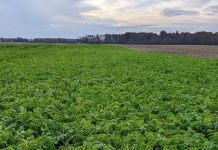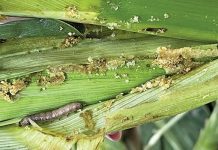Rosafield’s lady bovines have gone from strength to strength under the sure guidance of farm manager Tony Schwikkard. The herd belongs to George Archibald who owns Invernettie Estates, a group of farms mainly under sugarcane in the Umzinto district of KwaZulu-Natal. Rosafield Jerseys is just one facet of that enterprise and it is Tony’s input that has allowed the dairy herd to win the Jersey South Africa Model Herd award twice, in 2005 and now in 2008.
Tony farms as cleverly and strategically as possible to add value to every aspect of the dairy enterprise. “For me the most important aspects that need to be continuously improved are feed, milk quality, consistency of milk supply, and the value of the cows in relation to the Jersey stud market,” says Tony. “They must be well managed to improve the enterprise’s margins over input costs.” Rosafield Jerseys is run as a semi-total mixed ration herd. The cows are all fed a total mixed ration (TMR) for the first seven months of each lactation, and then they are put to pasture for the remaining three months, while they dry off. At any given time the herd consists of 150 cows in milk. The remainder of the herd, followers, dry cows and heifers, are also on pasture. Balance is best There is limited space for pasture on the Invernettie Estates farms as the land is predominantly under sugarcane.
This makes Tony’s TMR system even more important. He says a very scientific approach was needed. “At the moment the business makes about R23 profit per lactating TMR cow per day after only feed costs have been subtracted,” explains Tony. This does not include other input costs that still have to be subtracted from that profit margin. “A year or two ago, I could get away with a R15 margin over feed costs to break even, but now that break-even point is over R20 per cow per day as input costs have increased by an average 58% over the past 18 months. This has made a significant dent in the milk price increases.
I have had to improve the herd’s overall total production by improving the quality of the TMR ration, while keeping a close eye on input costs.” He explains that he has been able to source cheaper, but still good quality, ingredients such as brewer’s grain and barley powder. The brewer’s grain is a great source of fibre as it’s highly digestible and helps to improve the herd’s butterfat levels. Tony adds that this ingredient gives a good balance between protein and energy content. A dairy cow’s day Each lactating cow gets at least 22kg of dry matter per day, with an energy potential of about 12MJ/kg. The ration must also have at least 18% crude protein and the rumen digestible protein versus bypass protein ratio should be at about 62%:38%.
The fibre content should be about 16%. In addition, each cow’s intake should consist of about 28% Neutral Detergent Fibre and about 18% Acid Detergent Fibre (see glossary for definitions). “The ration ingredients are mixed to give the best milk production at its most economical,” continues Tony. “The ingredients that I use per cow per day are 2,5kg whole cottonseed, 1,2kg cotton-oil cake, 1,5kg molasses, 2kg hominy chop, 1,8kg lucerne hay, 2,2kg maize meal, 8kg fresh cut ryegrass, 3kg barley powder, 7kg maize silage, 0,6kg bran, and 6,5kg of brewer’s grain-based Voermol Econo 19.
Some of the ingredients are fresh, and if converted to dry matter amount to 22kg to 23kg per cow per day. The cost of this ration is R51 per cow per day and it produces between 22kg and 23kg of milk per day.” Another important consideration for Tony, when trying to maximise margins over feed costs, is to incorporate as much home-grown feed material into the TMR as possible. Because of the farm’s space limitations, he can only grow his own silage maize for grazing with ryegrass as a fresh chop. However, this relatively small yield has a positive effect on the cost and quality of the final ration.
Stud advantages In the last few years, Tony has emphasised maximising cow values via the Jersey stud market. He has identified 10 cow families in the Rosafield stud herd that have shown good lifelong milk production figures. Each of these cows can produce at least 30 000kg of milk in a lifetime, although it’s not uncommon for Rosafield cows to yield as much as 40 000kg or even 50 000kg. “The 30 000kg minimum is because I’d rather set an attainable target for the herd based on the circumstances of the enterprise,” explains Tony. “However, most of my cows easily achieve more than this in four lactations.
In addition to production traits, cow conformation is also important when maximising cow values. A cow with poor conformation will not be able to handle the demands of milk production.” The semen used on Rosafield’s cows is either American or Canadian. The bulls include Action, Blackstone, BW Country and Iatola. These bulls maintain the conformation traits that Tony is looking for in his cows, while adding value to the cows and their progeny. This paid off when Rosafield Jerseys achieved the top price of R28 500 for Rosafield Rockets Darling in-calf heifer, sold to Richard Bruton of Camperdown in KwaZulu-Natal at the 25th National Jersey Sale in Bloemfontein on 2 April 2008.
The herd also achieved the top selling price at the Golden Invitational Sale on 8 September 2007 in Parys, where Peter Durham of Dundee, also in KwaZulu-Natal, bought a Rosafield fresh-in-milk first calver for R26 500. “The most important part of bull selection for cows is to have bulls that will complement the conformation and production traits of a particular female line in the herd,“ explains Tony. “I have been able to achieve this management aspect over the years by careful selection and through a strict culling policy.” Contact Tony Schwikkard on (039) 971 1621 or fax (039) 971 1573. |fw








